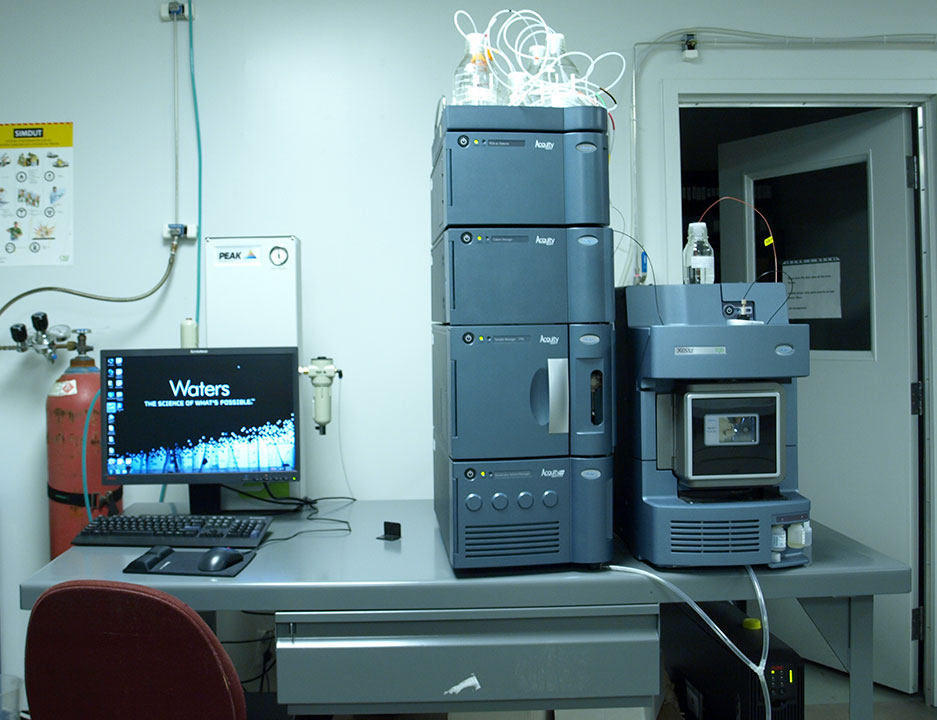Consumers rely on precise identification of botanical species and the quantity of marker compounds, especially when it relates to effectiveness on mood and stress. LC-MS/MS validates ingredients for identity and potency, ensuring consistent premium quality. It is able to detect compounds down to parts per trillion (10−12) Consumers can trust in products that work for them.
If the HPLC is the master specialist in identifying and quantifying, then the LC-MS/MS is the all-star. It is able to do everything the HPLC can do, only better and more precisely. It does this by using a very high-pressure micropump—15,000 psi—,combined with dual detector / photodiode array (PDA) and a more powerful mass spectrometer detector. It is used in cases where extreme sensitivity is needed.
Currently, this is the most advanced and widest-application tool for analysis. It allows for the most precise measurements—in parts per trillion rather than billion or million… The LC-MS/MS is able to effectively analyse herbs and medicinal components.
The LC/MS combines the advanced separation capabilities of an HPLC with the powerful analytical abilities of a mass spectrometer.
A sample is injected into the UPLC system and separated into its various components. These components enter the MS through an “electro spray interface,” where very rapid ionization takes place. At this point, the mass spectra of the components can be used to pinpoint-analyse the sample.
The main advantage of this system is that it generates fast, accurate, and extremely precise measurements by creating an electronic signature of a compound.
Below an image to replace to a right one
Additional text here
Additional info CHAT-GPT 🙂 but edit later
Ultra-High Pressure Liquid Chromatography coupled with Mass Spectrometry (UPLC-MS) is a powerful analytical tool used for the separation, identification, and quantification of compounds in complex samples. UPLC-MS combines the benefits of ultra-high-performance liquid chromatography (UPLC) with the capabilities of mass spectrometry, providing enhanced speed, sensitivity, and selectivity. Here are the key aspects of UPLC-MS as an analytical tool:
Ultra-High Pressure Liquid Chromatography (UPLC):
- Principle:
- UPLC operates on the same principles as traditional HPLC but with significant improvements in terms of column particle size and system pressure.
- UPLC employs columns with sub-2 micrometer particle sizes, allowing for higher resolution and faster separations.
- Advantages of UPLC:
- Increased Speed: Shorter analysis times due to higher efficiency and reduced peak widths.
- Enhanced Resolution: Improved separation of complex mixtures, leading to sharper and better-defined peaks.
- Reduced Sample Size: Smaller sample volumes are required for analysis.
- Instrumentation:
- UPLC systems include a high-pressure pump, an injector, a UPLC column with small particle sizes, and a detector.
- UPLC systems are designed to withstand high pressures, typically exceeding 15,000 psi (1000 bar).
Mass Spectrometry (MS):
- Principle:
- Mass spectrometry is a technique that ionizes compounds and separates the ions based on their mass-to-charge ratio (m/z).
- MS provides information on the molecular weight, structure, and fragmentation patterns of analytes.
- Advantages of MS:
- High Sensitivity: MS is highly sensitive, capable of detecting compounds at low concentrations.
- Structural Information: Provides structural information through fragmentation patterns, aiding in compound identification.
- Selective Detection: Mass spectrometers can be highly selective, reducing interference from matrix components.
- Instrumentation:
- MS systems consist of an ionization source, mass analyzer, and a detector.
- Common ionization techniques include electrospray ionization (ESI) and atmospheric pressure chemical ionization (APCI).
- Different mass analyzers, such as quadrupole, time-of-flight (TOF), and ion trap, are used based on the analytical requirements.
UPLC-MS Coupling:
- Efficient Separation:
- UPLC’s high-pressure system facilitates efficient chromatographic separations, producing narrow and well-resolved peaks.
- Sensitive Detection:
- The coupling of UPLC with MS allows for highly sensitive detection, enabling the analysis of trace-level compounds.
- Identification and Quantification:
- Mass spectrometry provides both qualitative and quantitative information. MS/MS experiments can be performed to obtain structural details.
- Applications:
- UPLC-MS is widely used in metabolomics, proteomics, pharmaceutical analysis, environmental monitoring, food and beverage analysis, and more.
Data Analysis:
- Software:
- Specialized software is used for data analysis, peak integration, compound identification, and quantification.
- Database Matching:
- Mass spectral data can be compared to databases for compound identification.
Challenges:
- Method Development:
- Developing robust UPLC-MS methods may require optimization of parameters such as mobile phase composition, ionization conditions, and mass spectrometer settings.
- Matrix Effects:
- Sample matrices can influence ionization efficiency and introduce matrix effects that need to be considered in quantitative analysis.
In summary, UPLC-MS is a versatile and powerful analytical tool that combines the efficiency of UPLC separations with the sensitivity and selectivity of mass spectrometry. It has become an essential technique in many fields of analytical chemistry and is particularly valuable for the comprehensive analysis of complex mixtures in diverse applications.




![Argan-oil-chromatogram[1]](https://nhplab.com/wpress/wp-content/uploads/Argan-oil-chromatogram1.jpg)
